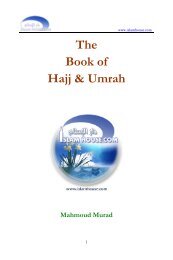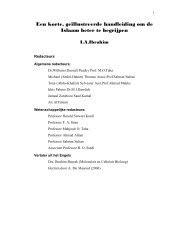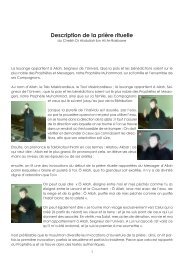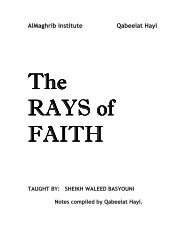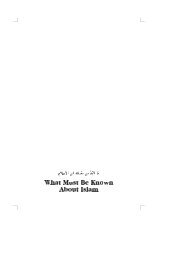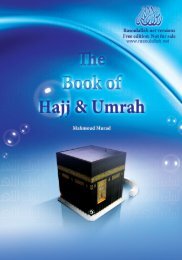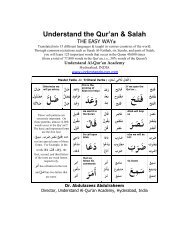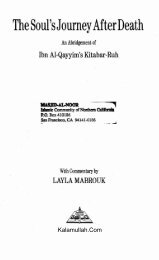Rules Governing The Criticism Of Hadith - Islam House
Rules Governing The Criticism Of Hadith - Islam House
Rules Governing The Criticism Of Hadith - Islam House
You also want an ePaper? Increase the reach of your titles
YUMPU automatically turns print PDFs into web optimized ePapers that Google loves.
memory of the reporters<br />
Under this classification falls the final verdict on a hadith, being one of the following: sahih, hasan,<br />
da'if or maudu'.<br />
Among the early traditionists, mostly of the first two centuries, ahadith were classified into two<br />
categories only: sahih and da'if; al-Tirmidhi was to be the first to distinguish hasan from da'if. This is<br />
why traditionists and jurists such as Ahmad, who seemed to argue on the basis of da'if ahadith<br />
sometimes, were in fact basing their argument on the ahadith which were later to be known as hasan.<br />
We now examine in more detail these four important classes of ahadith.<br />
Saheeh (sound)<br />
Hasan (agreeable)<br />
Da'eef (weak)<br />
Maudoo' (fabricated)<br />
Saheeh (sound)<br />
Al-Shafi'i states the following requirement in order for a hadith which is not mutawatir to be<br />
acceptable:<br />
"Each reporter should be trustworthy in his religion; he should be known to be truthful in his<br />
narrating, to understand what he narrates, to know how a different expression can alter the meaning,<br />
and report the wording of the hadith verbatim, not only its meaning. This is because if he does not<br />
know how a different expression can change the whole meaning, he will not know if he has changed<br />
what is lawful into what is prohibited. Hence, if he reports the hadith according to its wording, no<br />
change of meaning is found at all. Moreover, he should be a good memoriser if he happens to report<br />
from his memory, or a good preserver of his book if he happens to report from it. He shouId agree<br />
with the narrations of thehuffaz, if he reports something which they also do. He should not be a<br />
mudallis, who narrates from someone he met something he did not hear, nor should he report from the<br />
Prophet contrary to what reliable sources have reported from him. In addition, the one who is above<br />
him (in the isnad) should be of the same quality until the hadith goes back uninterrupted to the<br />
Prophet or any authority below him."<br />
Ibn al-Salah, however, defines a sahih hadith more precisely by saying:<br />
"A sahih hadith is the one which has a continuous isnad, made up of reporters of trustworthy<br />
preservers from similar authorities, and which is found to be clear from shudhudh and any defects."<br />
By the above definition, no room is left for any weak hadith, whether, for example, it is munqati',<br />
mu'dal, mudtarib, maqlub, shadhdh, munkar, ma'lul, or contains a mudallis. <strong>The</strong> definition also<br />
Page 16



